Investigation of the Dynamic Characteristics of an Eccentric Annular Seal on the Basis of a Transient CFD Method with Three Whirl Models
Abstract
:1. Introduction
2. Numerical Model and Calculation Method
2.1. Geometric Structure and Mesh
2.2. Identification Method of Seal Dynamic Coefficients

2.3. The Motion of Mesh
2.4. Calculation Method
3. Results
3.1. Theoretical and Experimental Verification
3.2. Effects of Static Eccentricities and Whirl Models on the Dynamic Characteristics of the Annular Seal
3.3. Effects of Whirl Amplitudes on the Dynamic Characteristics of the Annular Seal at Various Static Eccentricities
4. Conclusions
- The mesh morphing technique implemented by user-defined subroutines can update the grids in the clearance of the annular seal with the rotation of the rotor whirl at each time step, and the grids in the gap of the annular seal are without highly deformed grid cells and negative volume.
- The three whirl models of the transient CFD method demonstrate great improvement compared to the bulk flow model for the prediction of direct damping coefficients and cross-coupled damping coefficients, and the three whirl models have the highest prediction accuracy for direct damping coefficients, with a maximum error of 25%. Compared with the 1D whirl model and the elliptical whirl model, the circular whirl model is the best choice for obtaining high-precision damping and correctly capturing the trends of damping changing with static eccentricity.
- As static eccentricity increases, the dynamic characteristics coefficients of the eccentric annular seal are no longer characteristics with equal main terms and negative cross terms. Negative kyx increases significantly with increasing static eccentricity, and it increases by 166% when static eccentricity is increased from 0 to 0.5.
- Whirl amplitude has an obvious influence on the dynamic characteristics of eccentric annular seal when the static eccentricity is greater than 0.3, and 1% of Cr and 10% of Cr have great advantages when predicting direct virtual-mass and cross-coupled damping, respectively.
Author Contributions
Funding
Institutional Review Board Statement
Informed Consent Statement
Data Availability Statement
Conflicts of Interest
Nomenclature
| a | The major axis of elliptical whirl orbit (mm) |
| b | The minor axis of elliptical whirl orbit (mm) |
| BFM | Bulk flow model |
| CFD | Computational fluid dynamics |
| C | The center of stator |
| C’ | The center of rotor |
| C” | The static eccentric position |
| Cr | Seal clearance (mm) |
| cxx, cyy | Direct damping (Ns/m) |
| cxy, cyx | Cross-coupled damping (Ns/m) |
| d | The movement displacement of the rotor when moving from the concentric position to the eccentric position (m) |
| e | Circular whirl amplitude (mm) |
| EXP | Experiment |
| Fx | Fluid response force in x direction due to x direction excitation (N) |
| Fy | Fluid response force in y direction due to y direction excitation (N) |
| Fx0 | Fluid response force in x direction due to rotor static eccentricity (N) |
| Fy0 | Fluid response force in y direction due to rotor static eccentricity (N) |
| kxx, kyy | Direct stiffness (N/m) |
| kxy, kyx | Cross-coupled stiffness (N/m) |
| L | Seal length (mm) |
| mxx, myy | Direct virtual-mass (kg) |
| mxy, myx | Cross virtual-mass (kg) |
| PD | Pressure difference (MPa) |
| q | The maximum length–width ratio of grids when the rotor is in eccentric position |
| q0 | The maximum length–width ratio of grids when the rotor is in concentric position |
| R | Seal radius (mm) |
| Sc | The ratio of the distance between the nodes in the clearance and the outer wall to the clearance |
| xd | Relative rotor to stator displacement in x direction (m) |
| yd | Relative rotor to stator displacement in y direction (m) |
| θ | Initial angular displacement of Pi (rad) |
| ε | Eccentricity (mm) |
| εe | Eccentricity ratio (ε/Cr) |
| δ | 1D whirl amplitude (mm) |
| ω | Spinning speed (rpm) |
| Ω | Whirl speed (rpm) |
References
- Lakshminarayana, B. Fluid Dynamics and Heat Transfer of Turbomachinery; John Wiley and Sons: New York, NY, USA, 1996; p. 339. [Google Scholar]
- Chupp, R.E.; Hendricks, R.C.; Lattime, S.B.; Steinetz, B.M. Sealing in turbomachinery. J. Propul. Power 2006, 22, 313–349. [Google Scholar] [CrossRef]
- Childs, D.W. Finite-length solutions for rotordynamic coefficients of turbulent annular seal. J. Tribol. 1983, 105, 437–444. [Google Scholar] [CrossRef]
- Kim, C.H.; Childs, D.W. Analysis for rotordynamic coefficients of helically-grooved turbulent annular seals. J. Tribol. 1987, 109, 136–143. [Google Scholar] [CrossRef]
- Zhai, L.L.; Zhang, Z.J.; Chi, Z.H.; Guo, J. Dynamic analysis of liquid annular seals with herringbone grooves on the rotor based on the perturbation method. R. Soc. Open Sci. 2018, 5, 180101. [Google Scholar] [CrossRef] [PubMed] [Green Version]
- Xia, P.; Liu, Z.S.; Yu, X.Y.; Zhao, J.M. A transient bulk flow model with circular whirl motion for rotordynamic coefficients of annular seals. Chinese J. Aeronaut. 2018, 31, 1085–1094. [Google Scholar] [CrossRef]
- Dietzen, F.J.; Nordmann, R. Calculating rotordynamic coefficients of seals by finite-difference techniques. J. Tribol. 1987, 109, 388–394. [Google Scholar] [CrossRef] [Green Version]
- Feng, T.; Nordmann, R. Identification of fluid-structure interactions in centrifugal pumps (Part 1: Computational procedure). In Proceedings of the ISROMAC-4, Honolulu, HI, USA, 5–8 April 1992; 1992; pp. 34–43. [Google Scholar]
- Arghir, M.; Frene, J. Forces and moments due to misalignment vibrations in annular liquid seals using the averaged navier-stokes equations. J. Tribol. 1997, 119, 279–287. [Google Scholar] [CrossRef]
- Kim, N.; Rhode, D.L. A new CFD-perturbation model for the rotordynamics of incompressible flow seals. In Proceedings of the ASME Turbo Expo 2000: Power for Land, Sea and Air, Munich, Germany, 8–11 May 2000; pp. 1–9. [Google Scholar]
- Tam, L.T.; Przekwas, A.J.; Muszynska, A.; Hendricks, R.C.; Braun, M.J.; Mullen, R.L. Numerical and analytical study of fluid dynamic forces in seals and bearings. J. Vib. Acoust. 1988, 110, 315–325. [Google Scholar] [CrossRef]
- Subramanian, S.; Sekhar, A.S.; Prasad, B.V. Rotordynamic characteristics of rotating labyrinth gas turbine seal with centrifugal growth. Tribol. Int. 2016, 97, 349–359. [Google Scholar] [CrossRef]
- Moore, J.J. Three-dimensional CFD rotordynamic analysis of gas labyrinth seals. J. Vib. Acoust. 2003, 125, 427–433. [Google Scholar] [CrossRef]
- Pugachev, A.O.; Degen, H. CFD-predicted rotordynamic coefficients for a 20-teeth-on-stator labyrinth seal at high supply pressure conditions. In Proceedings of the ASME Turbo Expo 2012: Turbine Technical Conference and Exposition, Copenhagen, Denmark, 11–15 June 2012; pp. 1–11. [Google Scholar]
- Rao, J.S.; Saravanokumar, M. Numerical simulation of seal flow and determination of stiffness and damping coefficient. In Proceedings of the 7th IFToMM-Conference on Rotor Dynamic, Vienna, Austria, 25–28 September 2006; pp. 25–28. [Google Scholar]
- Williams, M.; Chen, W.; Brozowski, L.; Eastland, A. Three-dimensional finite difference method for rotordynamic fluid forces on seals. AIAA J. 1997, 35, 1417–1420. [Google Scholar] [CrossRef]
- Li, Z.G.; Li, J.; Feng, Z.P. Comparisons of rotordynamic characteristics predictions for annular gas seals using the transient computational fluid dynamic method based on different single-frequency and multifrequency rotor whirling models. J. Tribol. 2015, 138, 011701. [Google Scholar] [CrossRef]
- Voigt, A.J.; Ludiciani, P.; Nielsen, K.K.; Santos, I.F. CFD applied for the identification of stiffness and damping properties for smooth annular turbomachinery seals in multiphase flow. In Proceedings of the ASME Turbo Expo 2016: Turbomachinery Technical Conference and Exposition GT2016, Seoul, Korea, 13–17 June 2016; pp. 1–11. [Google Scholar]
- Yan, X.; Li, J.; Feng, Z.P. Investigations on the rotordynamic characteristics of a hole-pattern seal using transient CFD and periodic circular orbit model. J. Vib. Acoust. 2011, 133, 041007. [Google Scholar] [CrossRef]
- Yan, X.; He, K.; Li, J.; Feng, Z.P. Rotordynamic performance prediction for surface-roughened seal using transient computational fluid dynamics and elliptical orbit model. J. Power Energy 2012, 226, 975–988. [Google Scholar] [CrossRef]
- Jiang, X.K. Transient CFD Simulation on the Flow Field and Dynamic Characteristics of Annular Seals. Ph.D. Thesis, Zhejiang University, Hangzhou, China, 2016. [Google Scholar]
- Childs, D.W.; Arthur, S.P. Static destabilizing behavior for gas annular seals at high eccentricity ratios. In Proceedings of the ASME Turbo Expo 2013: Turbine Technical Conference and Exposition GT2013, San Antonio, TX, USA, 3–7 June 2013; pp. 1–7. [Google Scholar]
- Yang, Z.; San Andres, L.; Childs, D.W. Dynamic force performance of annular gas seals at off-center conditions. Tribol. T. 1994, 37, 33–42. [Google Scholar] [CrossRef]
- Zhang, W.F.; Yang, J.G.; Cao, H.; Guo, R.; Sun, D. Theoretical and experimental research of tangential fluid-induced force and its influence on stability in eccentric seal. J. Mech. Eng. 2011, 47, 92–98. [Google Scholar] [CrossRef]
- Li, Z.G.; Chen, Y.X.; Li, J. Investigation on the leakage and static dynamic characteristics of rotating seals at high eccentricity ratios. J. Xi’an Jiaotong Univ. 2017, 51, 1–7. [Google Scholar]
- Li, Z.G.; Li, J.; Feng, Z.P. Numerical investigation on the leakage and static stability characteristics of pocket damper seals at high eccentricity ratios. J. Eng. Gas Turbines Power 2017, 140, 042503. [Google Scholar] [CrossRef]
- Sun, D.; Lu, J.; Ai, Y.T.; Zhou, H.L.; Wang, Z. Dynamical characteristics of eccentric seal and novel floating self-adapt concentric seal concepts. J. Propul. Technol. 2018, 39, 2075–2084. [Google Scholar]
- Marquette, O.R.; Childs, D.W.; San Andres, L. Eccentricity effects on the rotordynamic coefficients of plain annular seals: Theory Versus experiment. J. Tribol. 1997, 119, 443–447. [Google Scholar] [CrossRef]
- Nelson, C.C.; Nguyen, D.T. Analysis of eccentric annular incompressible seals: Part 1—A new solution using fast fourier transforms for determining hydrodynamic force. J. Tribol. 1988, 110, 354–359. [Google Scholar] [CrossRef]
- Li, Z.G. Investigations on the Leakage Flow and Rotordynamic Characteristics of the Pocket Damper Seal. Ph.D. Thesis, Xi’an Jiaotong University, Xi’an, China, 2017. [Google Scholar]
- Li, Q.; Liu, S.L.; Yu, G.C.; Pan, X.H.; Zheng, S.Y. Lubrication and stability analysis of nonlinear rotor-bearing system. J. Zhejiang Univ. 2012, 46, 1729–1736. [Google Scholar]
- ANSYS Fluent 16.0. Theory Guide [CP/DK]; ANSYS Inc.: Canonsburg, PA, USA, 2011.
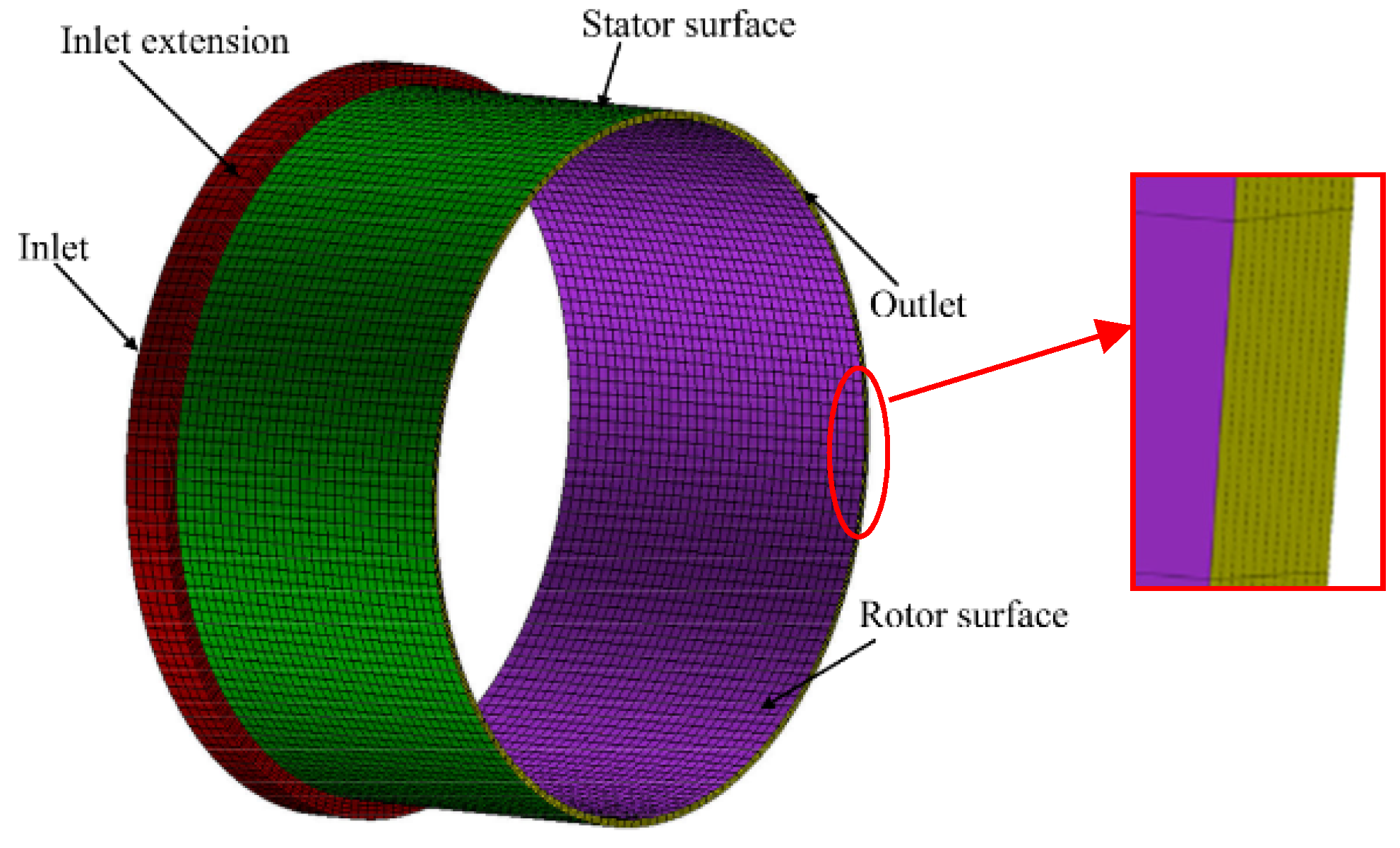
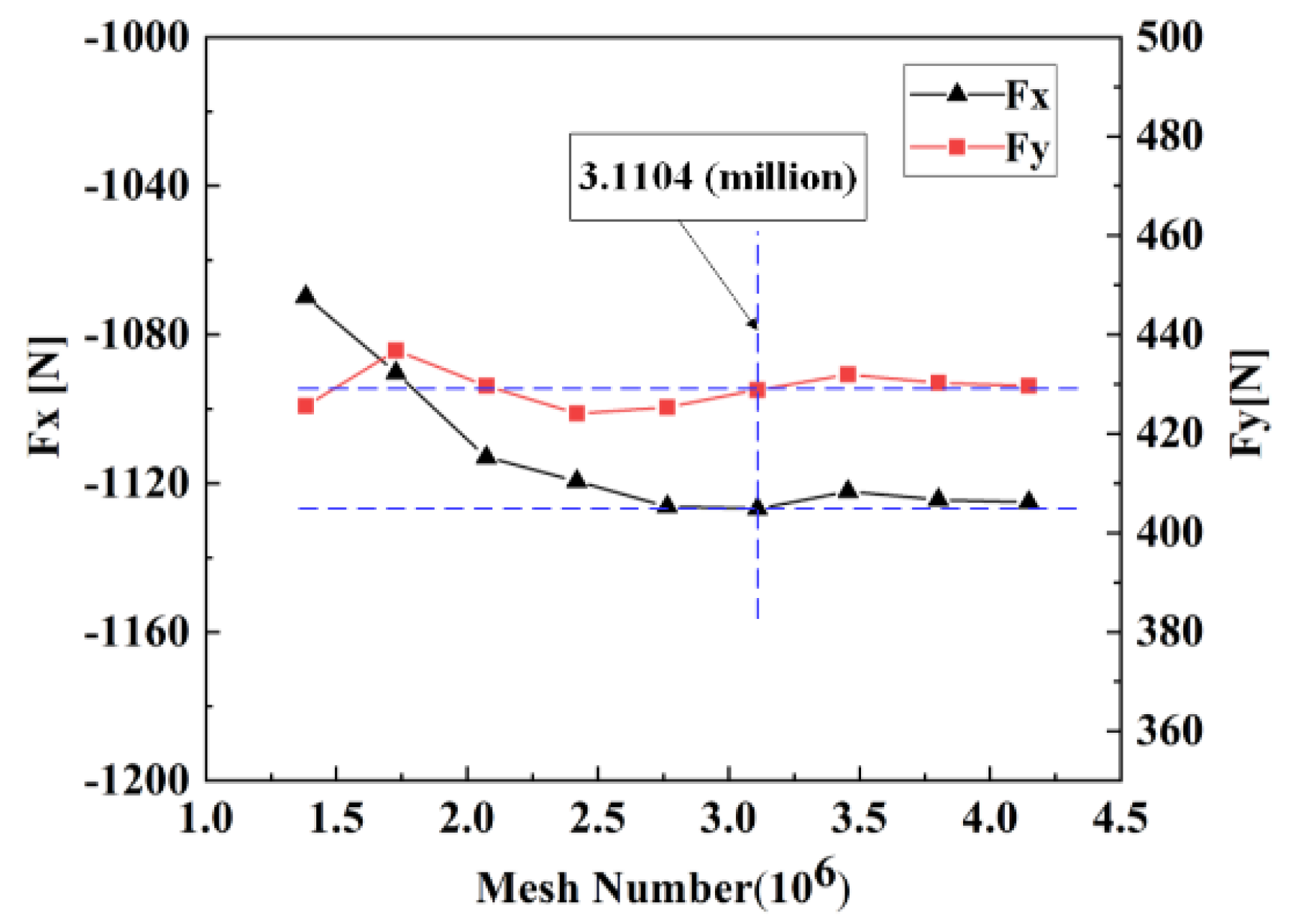
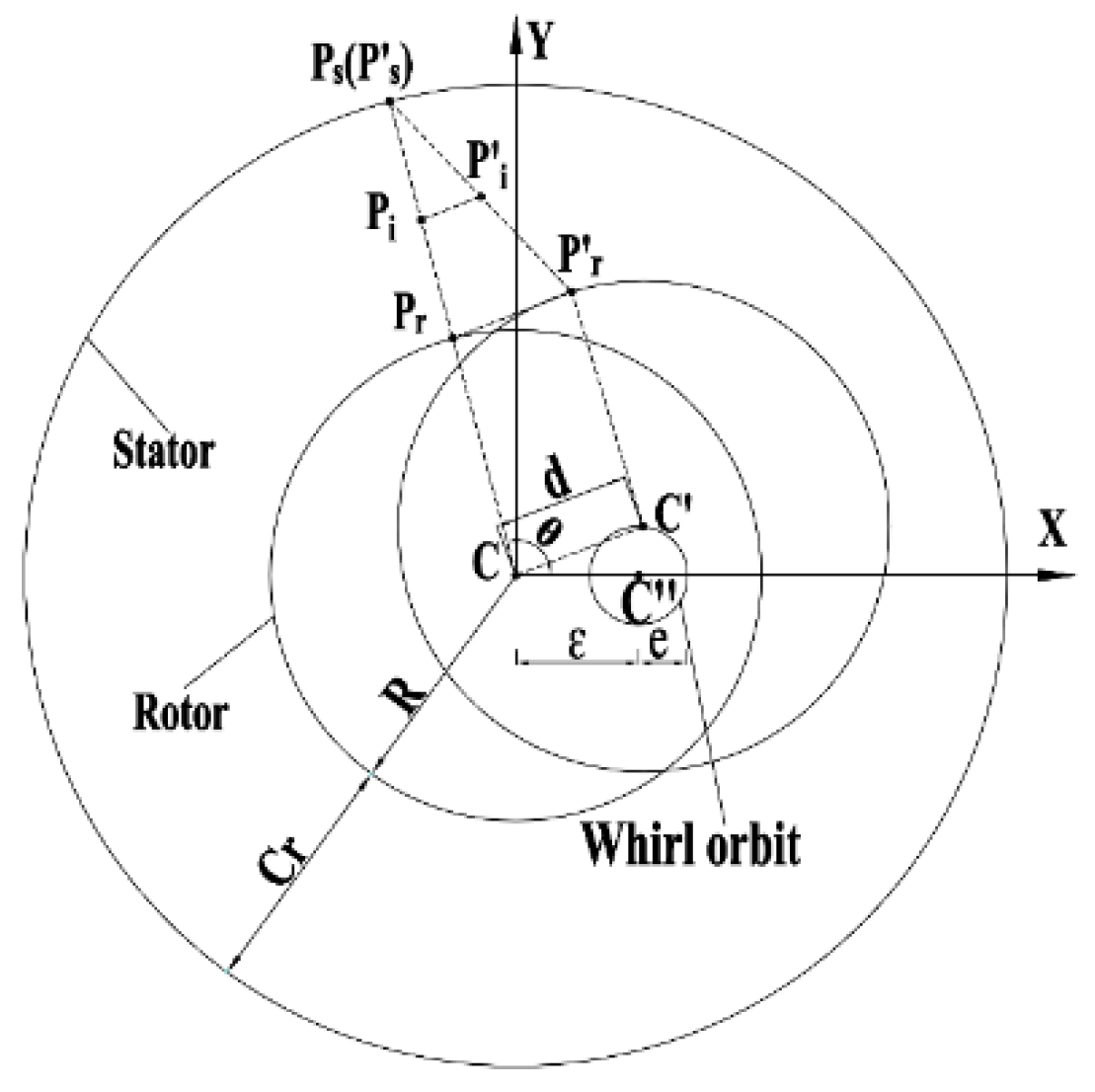
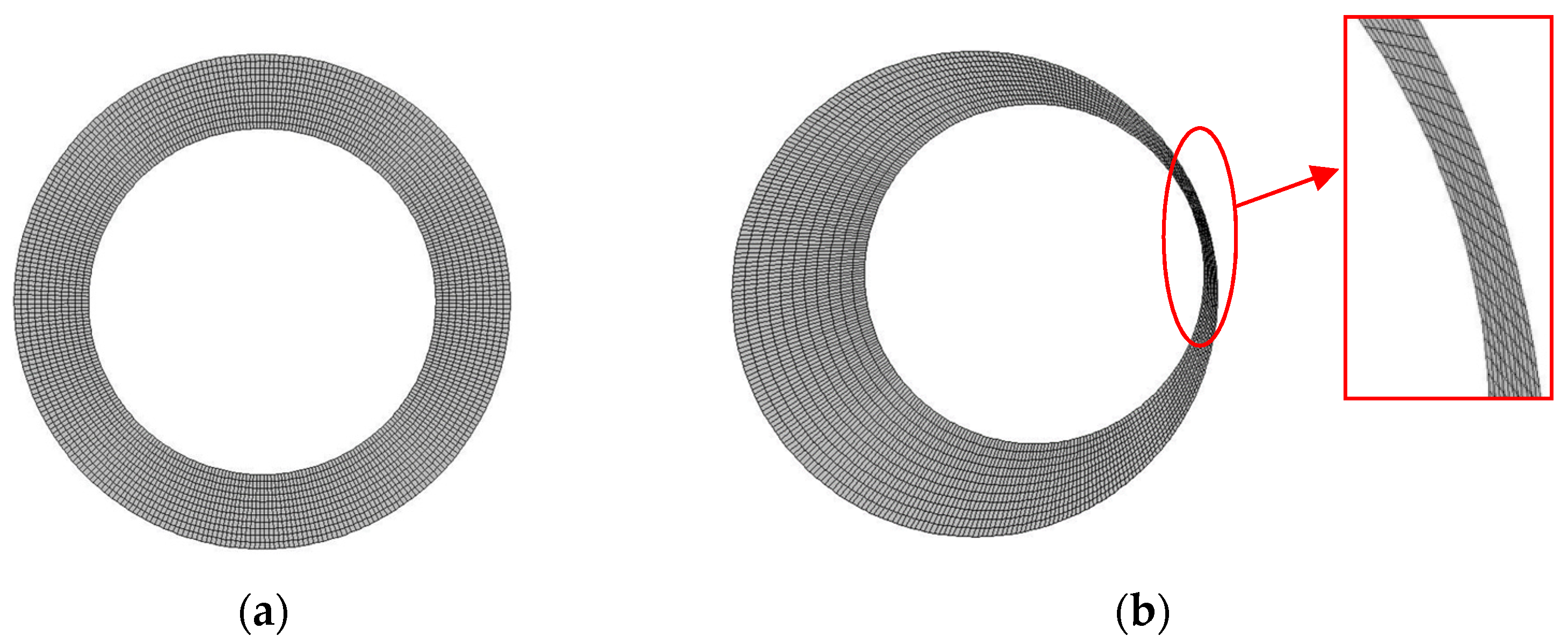
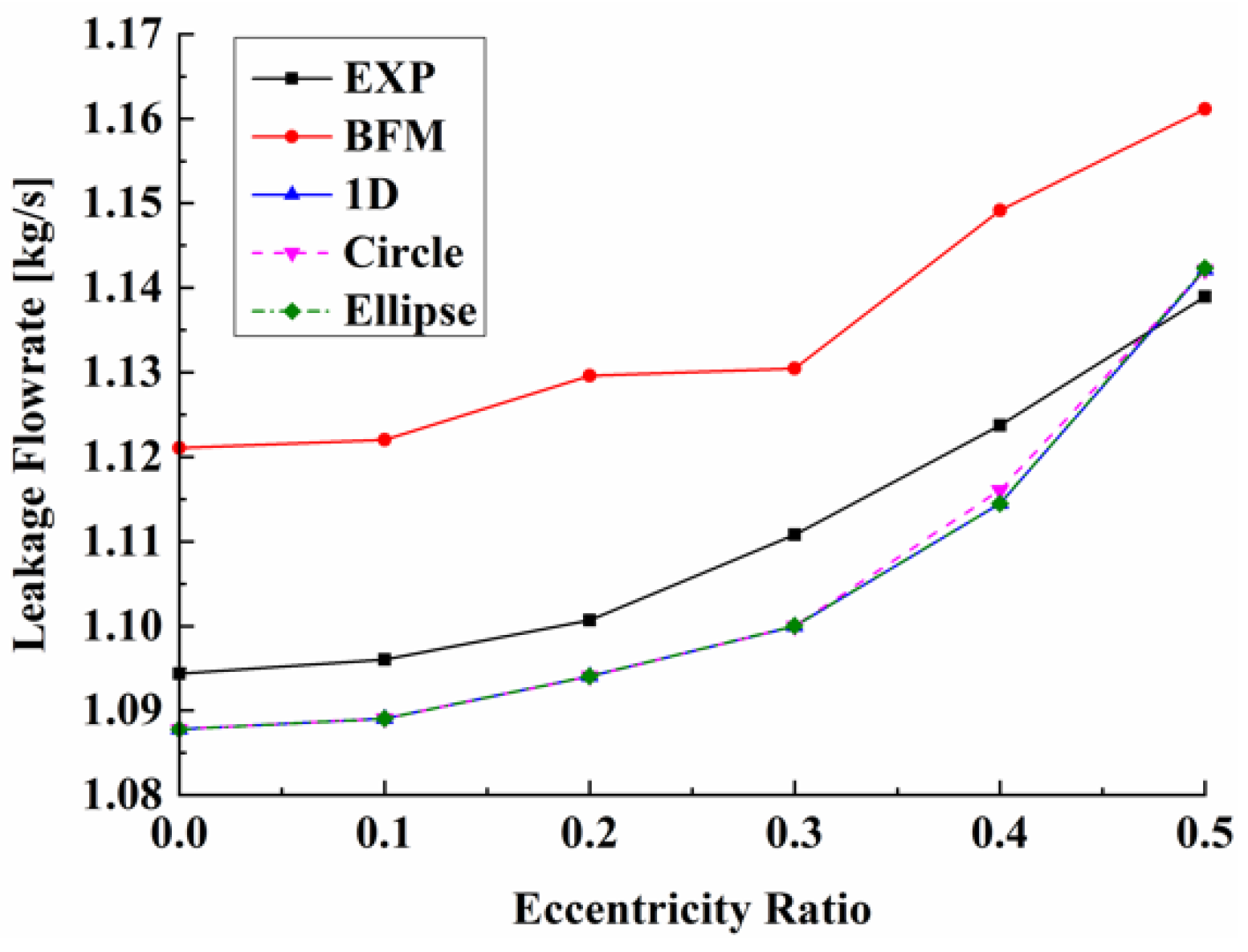
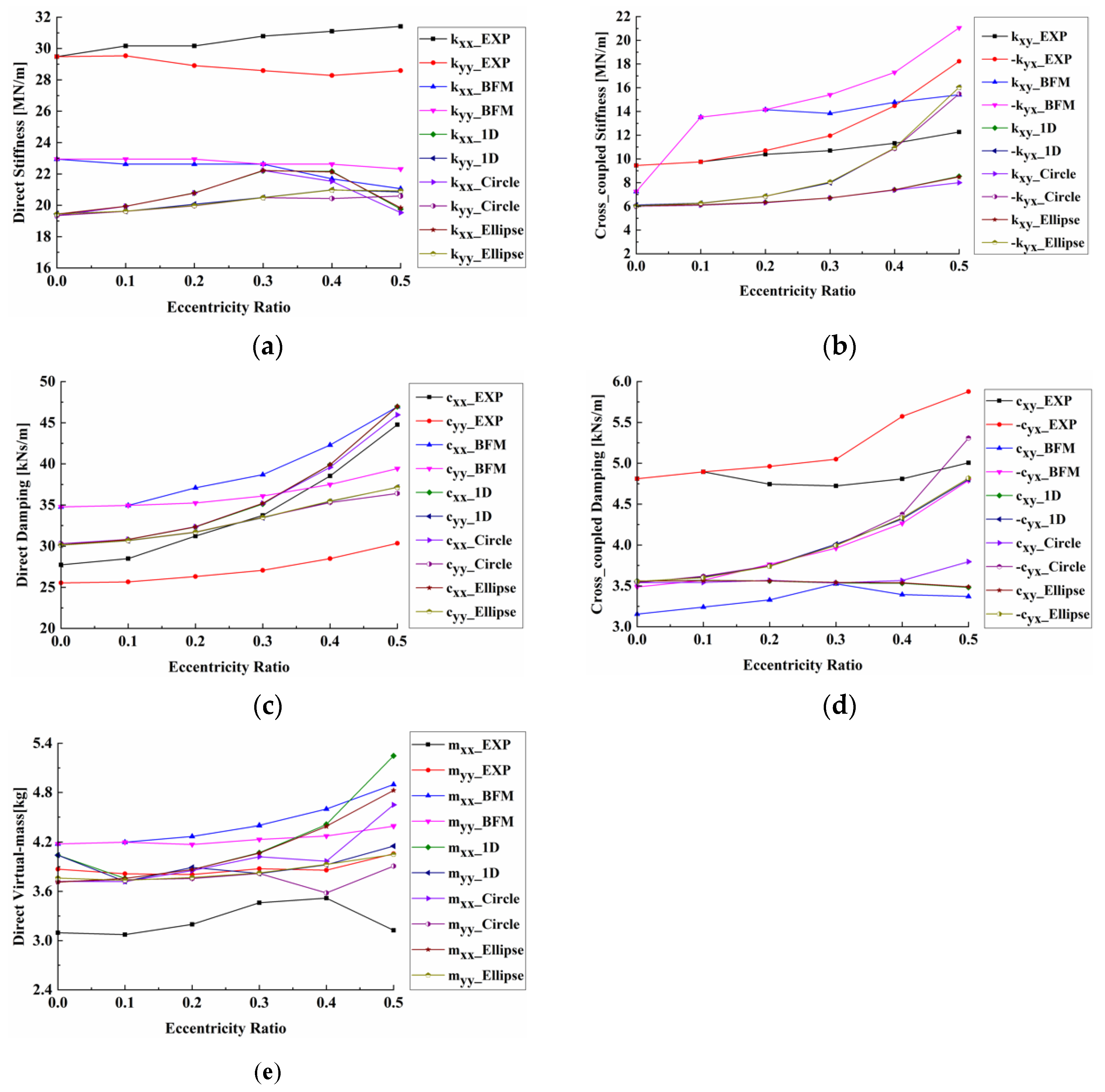

| Parameters | Symbols | Values |
|---|---|---|
| Seal radius | R | 38.145 mm |
| Seal clearance | Cr | 0.11 mm |
| Seal length | L | 34.93 mm |
| Static eccentricity ratio | εe | 0, 0.1, 0.2, 0.3, 0.4, 0.5 |
| Spinning speed | ω | 10,200 rpm |
| Pressure difference | PD | 6.89 MPa |
| L/2R ratio | - | 0.457 |
Publisher’s Note: MDPI stays neutral with regard to jurisdictional claims in published maps and institutional affiliations. |
© 2021 by the authors. Licensee MDPI, Basel, Switzerland. This article is an open access article distributed under the terms and conditions of the Creative Commons Attribution (CC BY) license (https://creativecommons.org/licenses/by/4.0/).
Share and Cite
Li, F.; Zhai, L.; Cui, B.; Guo, J.; Chen, G. Investigation of the Dynamic Characteristics of an Eccentric Annular Seal on the Basis of a Transient CFD Method with Three Whirl Models. J. Mar. Sci. Eng. 2021, 9, 1290. https://doi.org/10.3390/jmse9111290
Li F, Zhai L, Cui B, Guo J, Chen G. Investigation of the Dynamic Characteristics of an Eccentric Annular Seal on the Basis of a Transient CFD Method with Three Whirl Models. Journal of Marine Science and Engineering. 2021; 9(11):1290. https://doi.org/10.3390/jmse9111290
Chicago/Turabian StyleLi, Fengqin, Lulu Zhai, Baoling Cui, Jia Guo, and Guoyou Chen. 2021. "Investigation of the Dynamic Characteristics of an Eccentric Annular Seal on the Basis of a Transient CFD Method with Three Whirl Models" Journal of Marine Science and Engineering 9, no. 11: 1290. https://doi.org/10.3390/jmse9111290
APA StyleLi, F., Zhai, L., Cui, B., Guo, J., & Chen, G. (2021). Investigation of the Dynamic Characteristics of an Eccentric Annular Seal on the Basis of a Transient CFD Method with Three Whirl Models. Journal of Marine Science and Engineering, 9(11), 1290. https://doi.org/10.3390/jmse9111290





